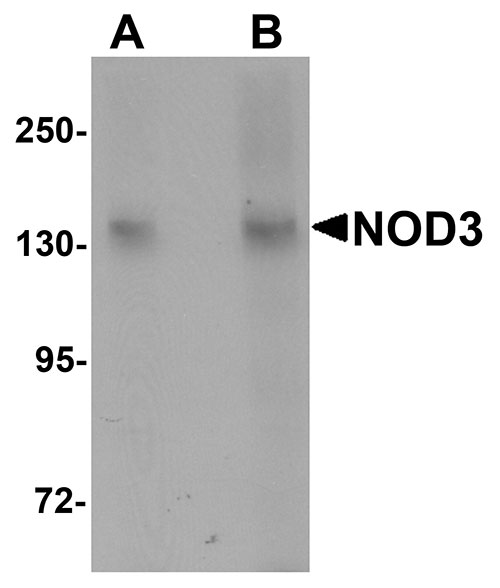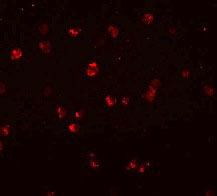NOD3 Antibody
- SPECIFICATION
- CITATIONS
- PROTOCOLS
- BACKGROUND

Application
| WB, IF, E |
|---|---|
| Primary Accession | Q7RTR2 |
| Other Accession | EAW85351, 119605757 |
| Reactivity | Human, Mouse, Rat |
| Host | Rabbit |
| Clonality | Polyclonal |
| Isotype | IgG |
| Calculated MW | 114658 Da |
| Application Notes | NOD3 antibody can be used for detection of NOD3 by Western blot at 1 - 2 µg/mL. Antibody can also be used for immunofluorescence starting at 20 µg/mL. For immunofluorescence start at 20 µg/mL. |
| Gene ID | 197358 |
|---|---|
| Target/Specificity | NLRC3; |
| Reconstitution & Storage | NOD3 antibody can be stored at 4℃ for three months and -20℃, stable for up to one year. As with all antibodies care should be taken to avoid repeated freeze thaw cycles. Antibodies should not be exposed to prolonged high temperatures. |
| Precautions | NOD3 Antibody is for research use only and not for use in diagnostic or therapeutic procedures. |
| Name | NLRC3 |
|---|---|
| Synonyms | NOD3 |
| Function | Negative regulator of the innate immune response (PubMed:15705585, PubMed:22863753, PubMed:25277106). Attenuates signaling pathways activated by Toll-like receptors (TLRs) and the DNA sensor STING/TMEM173 in response to pathogen-associated molecular patterns, such as intracellular poly(dA:dT), but not poly(I:C), or in response to DNA virus infection, including that of Herpes simplex virus 1 (HSV1) (By similarity) (PubMed:22863753). May affect TLR4 signaling by acting at the level of TRAF6 ubiquitination, decreasing the activating 'Lys-63'-linked ubiquitination and leaving unchanged the degradative 'Lys-48'-linked ubiquitination (PubMed:22863753). Inhibits the PI3K-AKT-mTOR pathway possibly by directly interacting with the posphatidylinositol 3-kinase regulatory subunit p85 (PIK3R1/PIK3R2) and disrupting the association between PIK3R1/PIK3R2 and the catalytic subunit p110 (PIK3CA/PIK3CB/PIK3CD) and reducing PIK3R1/PIK3R2 activation. Via its regulation of the PI3K-AKT-mTOR pathway, controls cell proliferation, predominantly in intestinal epithelial cells (By similarity). May also affect NOD1- or NOD2-mediated NF-kappa-B activation (PubMed:25277106). Might also affect the inflammatory response by preventing NLRP3 inflammasome formation, CASP1 cleavage and IL1B maturation (PubMed:25277106). |
| Cellular Location | Cytoplasm |

Thousands of laboratories across the world have published research that depended on the performance of antibodies from Abcepta to advance their research. Check out links to articles that cite our products in major peer-reviewed journals, organized by research category.
info@abcepta.com, and receive a free "I Love Antibodies" mug.
Provided below are standard protocols that you may find useful for product applications.
Background
NOD3 Antibody: NOD3 is a member of the NOD (nucleotide-binding oligomerization domain) family, a group of proteins that are involved in innate immune defense. NOD3 also known as NLR family CARD containing 3 (NLRC3), is predominantly expressed in the immune system, particularly in T lymphocytes, and its expression is strongly down-regulated following stimulation of the T-cell receptor complex and CD28, suggesting that NOD3 plays a role in attenuating the activation of T cells. NOD3 inhibits NF-kappaB, AP-1 and NFAT transcriptional activation in Jurkat T cells downstream of CD3/CD28 stimulation or treatment with PMA/ionomycin and decreases IL-2 and CD25 mRNA induction in activated cells.
References
Kufer TA, Banks DJ, and Philpott DJ. Innate immune sensing of microbes by Nod proteins. Ann. NY Acad. Sci.2006; 1072:19-27.
Conti BJ, Davis BK, Zhang J, et al. CATERPILLER 16.2 (CLR16.2), a novel NBD/LRR family member that negatively regulates T cell function. J. Biol. Chem.2005; 280:18375-85.
If you have used an Abcepta product and would like to share how it has performed, please click on the "Submit Review" button and provide the requested information. Our staff will examine and post your review and contact you if needed.
If you have any additional inquiries please email technical services at tech@abcepta.com.













 Foundational characteristics of cancer include proliferation, angiogenesis, migration, evasion of apoptosis, and cellular immortality. Find key markers for these cellular processes and antibodies to detect them.
Foundational characteristics of cancer include proliferation, angiogenesis, migration, evasion of apoptosis, and cellular immortality. Find key markers for these cellular processes and antibodies to detect them. The SUMOplot™ Analysis Program predicts and scores sumoylation sites in your protein. SUMOylation is a post-translational modification involved in various cellular processes, such as nuclear-cytosolic transport, transcriptional regulation, apoptosis, protein stability, response to stress, and progression through the cell cycle.
The SUMOplot™ Analysis Program predicts and scores sumoylation sites in your protein. SUMOylation is a post-translational modification involved in various cellular processes, such as nuclear-cytosolic transport, transcriptional regulation, apoptosis, protein stability, response to stress, and progression through the cell cycle. The Autophagy Receptor Motif Plotter predicts and scores autophagy receptor binding sites in your protein. Identifying proteins connected to this pathway is critical to understanding the role of autophagy in physiological as well as pathological processes such as development, differentiation, neurodegenerative diseases, stress, infection, and cancer.
The Autophagy Receptor Motif Plotter predicts and scores autophagy receptor binding sites in your protein. Identifying proteins connected to this pathway is critical to understanding the role of autophagy in physiological as well as pathological processes such as development, differentiation, neurodegenerative diseases, stress, infection, and cancer.



